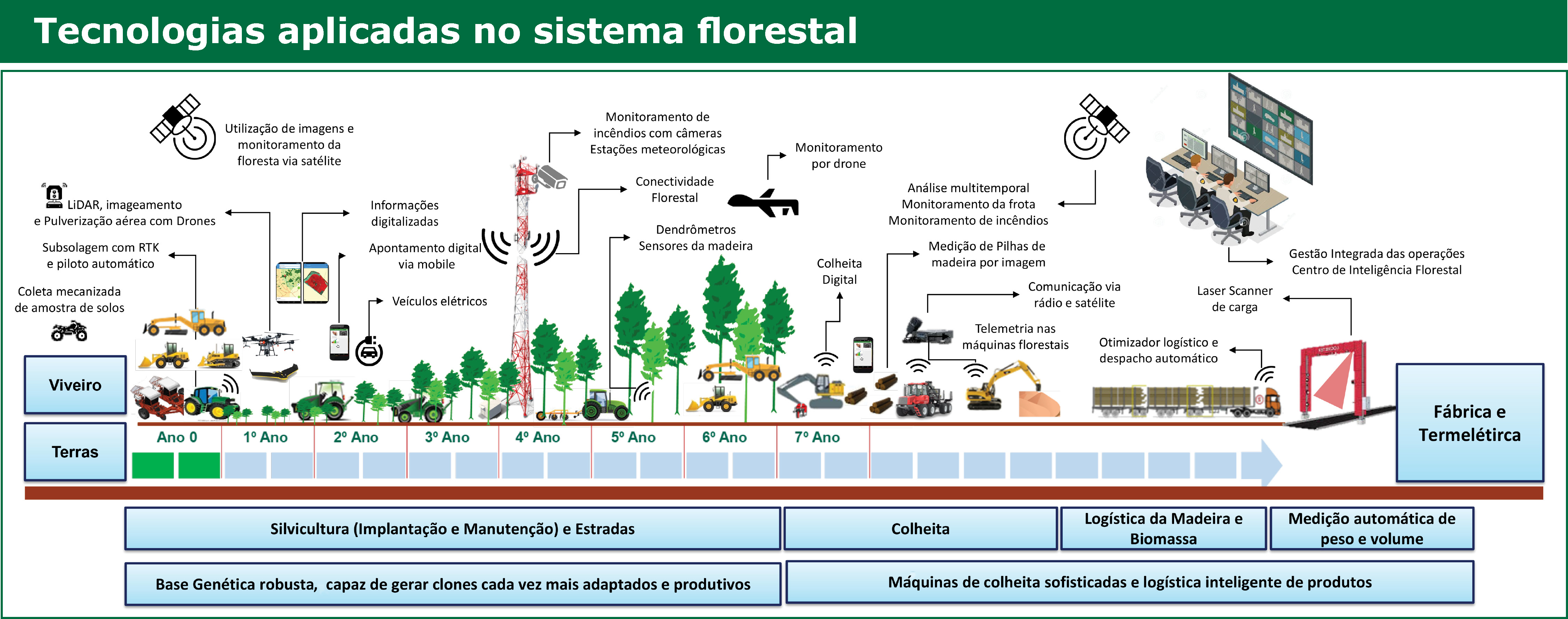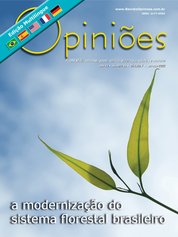Germano Aguiar Vieira
Diretor Florestal da Eldorado
OpCP69
modernização do sistema florestal brasileiro
Como sabemos, o Sistema Florestal Brasileiro se destacou ao longo dos últimos anos como um dos mais bem-sucedidos do mundo, assim como todo o agronegócio do Brasil.
Temos uma aptidão natural para sermos competitivos, como clima e solos suficientes para nos colocar no topo do ranking florestal, e nosso avanço foi pavimentado não apenas por muito esforço técnico e científico como também por empreendedores que acreditaram no setor.
Também é certo dizer que tudo isso aconteceu nos últimos 120 anos, mais expressivamente nos últimos 50. Trata-se, portanto, de um período muito curto para dizer que já passamos por experiências suficientes, que já estamos maduros e não há mais nada o que fazer.
Em minha opinião, estamos vivendo um período de fortes mudanças nos aspectos científico, cultural, social, tecnológico e climático, que deverá nortear o setor para os próximos anos. No aspecto científico, temos aumentado nosso conhecimento da cultura de eucalipto e pínus através de resultado de experiências e experimentações das empresas de base florestal; são mais de 10 milhões de hectares plantados em várias regiões do País.
Internalizamos, no setor, uma cultura de sustentabilidade, com forte viés ambiental e social, a não tolerância a nenhum tipo de racismo e segregação, e implantamos uma governança nas nossas empresas que garante o emprego de boas práticas administrativas e gerenciais.
No campo social, criamos indicadores para mostrar os efeitos de nossa organização nas comunidades onde atuamos, melhoramos nossos postos de trabalho, aumentando a segurança laboral, e criamos um ambiente de trabalho cada vez mais amigável.
Pegamos carona no pool de desenvolvimento tecnológico mundial dos últimos anos e passamos a utilizar bastantes soluções nas áreas de interpretação de imagens, telemetria, algoritmos para decisões diversas, equipamentos de mensuração, IoT e conectividade de campo.
Assustamo-nos, mas aprendemos muito com as anomalias climáticas vivenciadas nos últimos anos, que ocasionaram expressiva redução de produtividade da floresta plantada, aumento de incêndios e pragas florestais, colocando em dúvida nossos protocolos de melhoramento e manejo florestal. Mas o que pode ser entendido como modernização do setor de florestas plantadas?
A modernização de um setor produtivo do agronegócio tem várias vertentes, mas, nesta abordagem, somente falaremos dos aspectos técnicos, deixando para outra oportunidade temas estratégicos, culturais e institucionais.
O primeiro passo para realizar um bom projeto florestal é o conhecimento detalhado do ambiente onde queremos plantar uma floresta, ou seja, o solo e o clima. Nesse caso, o estado da arte nos apresenta soluções específicas de análises física e química de solos, através de equipamentos de amostragem e também da utilização de imagens que resgatam o uso desse solo em diferentes épocas. Eficientes estações meteorológicas serão necessárias para nos apoiar com nosso manejo, além de uma boa análise no histórico climático da região, que pode nos dar informações importantes para estabelecermos o melhor manejo e o material genético adequado para cada local.
O emprego de drones e VANTs também nos permite mapear com precisão nossas linhas de plantio, demarcarmos estradas/aceiros, área de preservação e reserva legal. Com o auxílio de tecnologia RTK e piloto automático, garantimos o melhor aproveitamento do solo, respeitando todos os marcos legais e um melhor fluxo de retirada da madeira no futuro. Com auxílio de softwares específicos, podemos definir a nutrição ideal para cada produtividade florestal possível, combinando tipo de adubo e coeficiente de utilização biológica de cada clone.
Vários projetos de plantadeira e irrigadores mecanizados já estão em operação nas empresas, e outros tantos, em teste, para melhorar a atividade de plantio, aperfeiçoando os postos de trabalho da equipe e ainda aumentando a produtividade dos recursos utilizados.
Medições de florestas têm recebido aliados importantes, como metodologias de análise por redes neurais, imagens e tecnologia LiDAR (Light Detection and Ranging).
A colheita da floresta responde por um importante custo dessa atividade, mas não faltam máquinas de alta tecnologia para efetuar essa tarefa de maneira eficaz e que tem sido aprimorada a cada ano pelos seus fabricantes. Não menos relevante, o transporte da madeira vem sendo apoiado com veículos cada vez mais adequados, softwares de gestão de logística e aprimoramento da infraestrutura de estradas e acessos às fazendas.
Inventários de estoques e medições de madeira também receberam auxílio valioso de equipamentos e software para garantir a precisão necessária. A conectividade no campo aliada a sofisticados sensores de telemetria antecipam as decisões de manutenção, aumentando a disponibilidade mecânica e a vida do ativo.
Tudo isso se resume a uma silvicultura muito mais eficiente do que tivemos alguns anos atrás, porém ainda estamos perdendo muito com as anomalias climáticas dos últimos anos, e a nova fronteira de excelência deve aportar mais tecnologia para um maior conhecimento da genética florestal, do clima, do solo, da planta e a interação entre eles.
Na ilustração em destaque, podemos ver o estado da arte da modernização das atividades florestais no Brasil.





